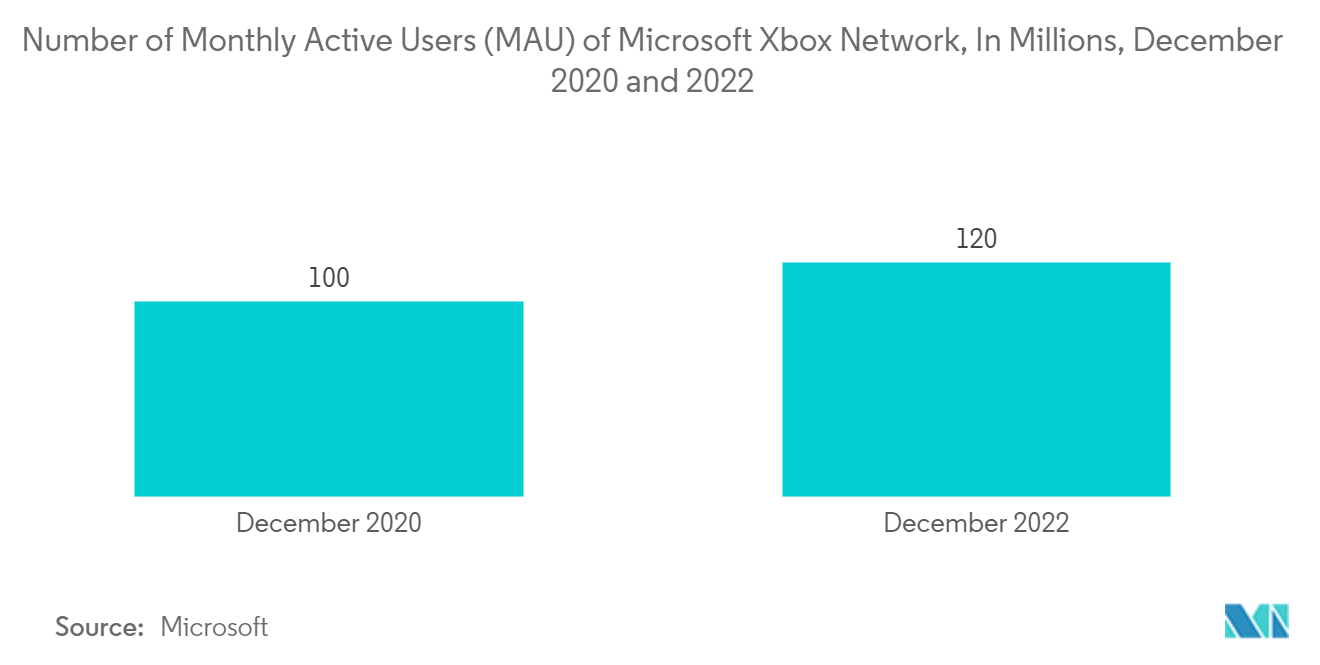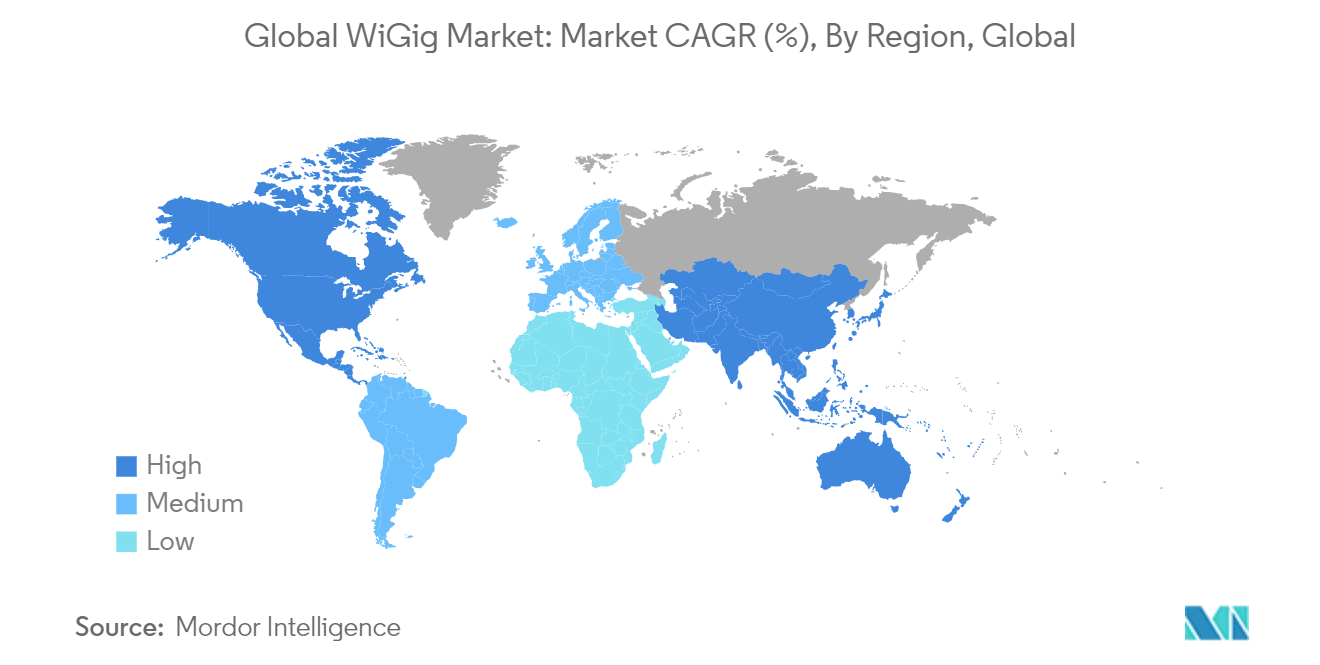Market Trends of WiGig Industry
Gaming and Multimedia Expected to Drive the Market
- The more complex online multiplayer games educate players on strategically and analytically assessing risk and reward. These games require young players to react fast to game changes. Children gain from this game because the abilities learned can be applied to real-world careers that require problem-solving, analytical skills, and strategic thinking. Games may be a terrific method for children to learn about diverse ideas and cultures since they allow them to immerse themselves in virtual worlds and, at times, communicate with people from all over the world. Such trends would raise the demand for the wireless gigabit market in gaming.
- In recent years, the internet ecosystem has initiated course correction by end-to-end local game development. For instance, Zynga's shift from social to mobile meant several tough years, but in February 2022, it reported Q4 revenue of USD 727 million, up by 52% year-over-year. It launched its free game Farmville-3 in June 2019, but the Flash-based game created by Zynga was primarily designed to be played within Facebook.
- According to the Mobile Video Industry Council, mobile operators expected cloud gaming to represent 25-50% of 5G data traffic by 2022, owing to the quick progression of cloud gaming services in recent months. Over-the-top (OTT) players also have ambitious plans to become the 'Netflix for gaming,' hosting libraries of thousands of immediately accessible games that will ultimately consume three to four times the amount of bandwidth on 5G networks compared to standard definition video traffic. Such high bandwidth will require the use of WiGig in coming future.
- Additionally, According to Microsoft, Microsoft's online gaming service had around 120 million monthly active users as of December 2022, up from just under 40 million at the start of 2016. The service was previously known as Xbox Live until being rebranded as Xbox Network in March 2023 to distinguish it from the Xbox Live Gold subscription service offering. Such a rise in demand for online consoles is expected to drive the studied market.
- Furthermore, In January 2023, the Razer Edge will be available in the United States through Verizon. The Razer Edge is powered by a Snapdragon G3x Gen 1 processor, which appears to be based on the Snapdragon 888. The 6.8" AMOLED display with 2,400 x 1,080px resolution (20:9) and 144Hz refresh rate provides it an advantage (heh) over the likes of the Steam Deck and the Nintendo Switch. In comparison, the Switch OLED has a 7-inch display, and the Steam Deck has a 7-inch LCD, but both feature just 720p resolution and run at 60Hz.

Asia-Pacific is Expected to Register the Highest Market Growth
- IEEE 802.11aj, an amendment to IEEE 802.11TM that specifies the Physical (PHY) layer and the Medium Access Control (MAC) layer in the 60 GHz and 45 GHz bands to accommodate expanding high-speed wireless LAN capacity demands in China, was authorized by IEEE and the IEEE Standards Association (IEEE-SA). The standard modification defines four 1.08 GHz channels in the 60 GHz band to support low-power devices with high data rates and broader coverage areas, as well as 5 GHz of new bandwidth in the 45 GHz band with up to a 15 Gb/s data rate. This enhances the capabilities of IEEE 802.11, the foundation of Wi-Fi networking equipment.
- In September 2022, Fujikura Ltd. developed and began distributing samples of a 60 GHz millimeter-wave wireless communication module that may be independently verified for Technical Regulations Conformity Certification in Japan, which does not require a license. The newly developed 60 GHz band millimeter-wave wireless communication module's structure has been upgraded and optimized to qualify for Technical Regulations Conformity Certification. This module will be provided with a certifying body's Technical Rules Conformity Certification mark. Its pre-certification greatly simplifies the development of communication and industrial equipment with the module.
- In February 2022, Nippon Telegraph and Telephone Corporation, Japan implemented 60-GHz band wireless LAN (WiGig) for the first time globally, achieving uninterrupted large-capacity wireless transmission in high-speed mobility situations using terminal-driven dynamic site diversity control technology. NTT's terminal-driven dynamic site diversity control technology enables even non-mobile wireless communication systems like WiGig to achieve continuous high-capacity wireless connections to high-speed mobile terminals. It can be utilized for real-time video transmission from drones and autos and batch data transmission.
- Similarly, recently, the ITU-APT Foundation of India (IAFI), a telecom industry organization, has pushed to delicense spectrum in the V-band (60 GHz range), allowing it to be granted without auctions and so keeping costs low, thereby aiding in the government's 'WiFi-for-all' effort to bridge the digital divide. Additionally, new technologies in the 60 GHz band (57-64 GHz) can achieve cost points an order of magnitude lower than existing fiber while providing fiber-like reliability and multigigabit speeds. Certain new 60 GHz band technologies can offer cost savings of one or two orders of magnitude over fiber and conventional milli-metric band backbone networks.
- The rising understanding of the benefits of phased array antenna and electronic beam-steering technology among operators and equipment makers is now translating into a debate among regulatory committees. Lattice recently participated in a technical analysis conducted by Huawei that forms the basis of a multi-company proposal to the Fixed Service working group in CEPT (ECC SE 19) advocating regulatory reform as part of this effort. Lattice provided the system parameters for their current wireless infrastructure solution, allowing Huawei to simulate the propagation characteristics and interference probability in an urban deployment simulation.
- The only way to wirelessly stream high quality, low latency 4K video across devices is at 60 GHz. Other wireless solutions must drastically compress 4K video, resulting in a lower quality and higher latency video experience. There aren't any cords. 60 GHz enables for smooth wireless communications between devices, removing the need for obtrusive cords and wires. The 60 GHz spectrum has 7 GHz of bandwidth, which provides the required capacity for the expanding number of Internet-connected devices. The amount of data that individuals utilize and the number of linked gadgets will only grow. The 60 GHz band can handle more data and connections while providing a better user experience.

